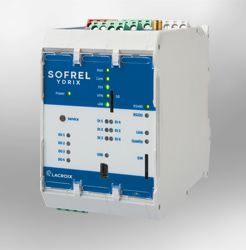Water treatment stations and plants are responsible for turning untreated water collected from the water table or directly from flowing surface water into drinkable water. A series of biological, physical and even chemical treatments are carried out there with the ever-present objective of providing the AEP network with water that meets health regulation requirements.
Telemetry and automation functions adapted for all infrastructures
Telemetry plays different roles depending on the installation’s size and type.
In a small plant, the treatment process is very simple. It is just filtration and disinfection. The SOFREL Remote Terminal Unit directly manages the information (e.g. on/off states, pump malfunctions, chlorine levels). It can also perform automated tasks, such as managing the pumping based on the water level in the reservoir being supplied by the station.
In a large plant where the drinking water treatment process is more complex, the RTU is usually connected to a PLC or a network of controllers. This is particularly true in large drinking water production plants which collect large quantities of water from rivers and lakes to treat. These complex installations are typically divided by function into units responsible for different treatment processes such as screening, coagulation, decantation, filtration, ozonation, refinement (activated carbon) and lastly disinfecting the water.
Through its communication functions, the SOFREL RTU is able to receive the essential information via the PLC about the treatment process and can be operated remotely. When the operator connects to the local station, they provide their installation management instructions which the RTU forwards to the PLC. These instructions can also come from other sites communicating with the station (intersite function). The PLCs and telemetry equipment thus complement each other.
Pumping instructions sent from the reservoirs
The intersite communication function enables multiple devices to communicate remotely via M2M.
Local “master” stations located in reservoirs send pumping instructions to the water treatment station/plant when the water level in the reservoirs is low. Upon receiving the instructions, the telemetry equipment will either activate the pumping or, if it is connected to a PLC, it will send a request to the controller to start the pumping.
Depending on how much water is left and what the analysis says about future consumption, it is possible to delay pumping so that it is performed during the off-peak hours for electricity.






